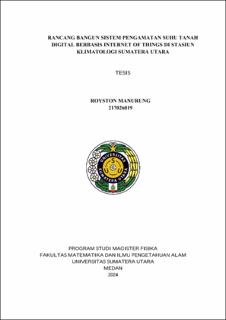| dc.description.abstract | Soil temperature, as one of important parameters in monitoring and
understanding climate and soil ecosystems, has a crutial role in various aspects of
the environment, including agriculture, ecology, and geoscience. Monitoring soil
temperature is required for planning and managing agriculture and natural
resources. Currently, temporally, ground temperature observations by BMKG
(Meteorologyl, Climatology, and Geophysics Agency) are still limited, namely only
carried out at 07:55, 13:55, and 18:55 local time. This makes it difficult to carry
out soil temperature analysis. This research is carried out to design a digital soil
temperature observation tool that can be accessed via the internet network. A set
of seven DS18B20 sensors, at depths of 0 cm, 2 cm, 5 cm, 10 cm, 20 cm, 50 cm, and
100 cm respectively are combined with the ESP8266 module using the Arduino
system. The implementation of the design produces a real-time soil temperature
observation system every 10 seconds. Observation data is displayed on a 20x4 LCD
and sent to the cloud so that it accessed on the web page
http://monitoringsuhutanah.my.id. The calibration results state that the DS18B20
sensors used in this research produces accurate and consistent temperature
measurements with an average correction ranging from (-0.20) to 0.24, making it
suitable for operation. Field tests results show that digital data is accurate and in
agreement (linearly correlated) with conventional data. This is based on the
correlation value which reaches 0.7, while the RMSE value ranges from 0.5 to 2.18,
and bias ranges from (-0.69) to 0.08. Temporal analysis shows the diurnal pattern
of soil temperature, namely peaks in the afternoon and valleys in the evening and
early morning. It can be seen that the soil temperature in the surface layer (0 cm, 2
cm, and 5 cm) has the highest variability, while the soil temperature in deep layers
(50 cm and 100 cm) appears more unvarying. In addition, effect of solar radiation
and rain on soil temperature variability analysis is also carried out. The result is
that an increase in solar radiation causes an increase in soil temperature, while
the occurrence of rain in the morning and afternoon causes a low soil temperature. | en_US |


